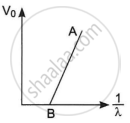Advertisements
Advertisements
प्रश्न
In which of the following situations, the heavier of the two particles has smaller de Broglie wavelength? The two particles
(a) move with the same speed
(b) move with the same linear momentum
(c) move with the same kinetic energy
(d) have fallen through the same height
उत्तर
(a) move with the same speed
(c) move with the same kinetic energy
(d) have fallen through the same height
Let m1 be the mass of the heavier particle and m2 be the mass of the lighter particle.
If both the particles are moving with the same speed v, de Broglie wavelength of the heavier particle,
`λ_1 = h/(m_1v)` ....(1)
de Broglie wavelength of the lighter particle,
`λ_2 = h/(m_2v)` ....(2)
Thus, from equations (1) and (2), we find that if the particles are moving with the same speed v, then `λ_1< λ_2`.
Hence, option (a) is correct.
If they are moving with the same linear momentum, then using the de Broglie relation `λ = h/p`
We find that both the bodies will have the same wavelength. Hence, option (b) is incorrect.
If K is the kinetic energy of both the particles, then de Broglie wavelength of the heavier particle,
`λ_1 = h/sqrt(2m_1K)`
de Broglie wavelength of the lighter particle,
`λ_2 = h/sqrt(2m_2K)`
It is clear from the above equation that if `m_1 > m_2` , then `λ_1 < λ_2`.
Hence, option (c) is correct.
When they have fallen through the same height h, then velocity of both the bodies,
`v = sqrt(2gh)`
Now ,
`λ_1 = h/(m_1sqrt(2gh)`
`λ_2 = h/(m_2sqrt(2gh)`
`m_1>m_2`
`therefore λ_1 < λ_2`
Hence, option (d) is correct.
APPEARS IN
संबंधित प्रश्न
Draw graphs showing variation of photoelectric current with applied voltage for two incident radiations of equal frequency and different intensities. Mark the graph for the radiation of higher intensity.
Can we find the mass of a photon by the definition p = mv?
What is the speed of a photon with respect to another photon if (a) the two photons are going in the same direction and (b) they are going in opposite directions?
Should the energy of a photon be called its kinetic energy or its internal energy?
In an experiment on photoelectric effect, a photon is incident on an electron from one direction and the photoelectron is emitted almost in the opposite direction. Does this violate the principle of conservation of momentum?
It is found that yellow light does not eject photoelectrons from a metal. Is it advisable to try with orange light or with green light?
It is found that photosynthesis starts in certain plants when exposed to sunlight, but it does not start if the plants are exposed only to infrared light. Explain.
If an electron has a wavelength, does it also have a colour?
If the frequency of light in a photoelectric experiment is doubled, the stopping potential will ______.
Photoelectric effect supports quantum nature of light because
(a) there is a minimum frequency below which no photoelectrons are emitted
(b) the maximum kinetic energy of photoelectrons depends only on the frequency of light and not on its intensity
(c) even when the metal surface is faintly illuminated the photoelectrons leave the surface immediately
(d) electric charge of the photoelectrons is quantised
The collector plate in an experiment on photoelectric effect is kept vertically above the emitter plate. A light source is put on and a saturation photocurrent is recorded. An electric field is switched on that has a vertically downward direction.
The work function of a metal is 2.5 × 10−19 J. (a) Find the threshold frequency for photoelectric emission. (b) If the metal is exposed to a light beam of frequency 6.0 × 1014 Hz, what will be the stopping potential?
(Use h = 6.63 × 10-34J-s = 4.14 × 10-15 eV-s, c = 3 × 108 m/s and me = 9.1 × 10-31kg)
Define the term: threshold frequency
Define the terms "stopping potential' and 'threshold frequency' in relation to the photoelectric effect. How does one determine these physical quantities using Einstein's equation?
In photoelectric effect, the photoelectric current started to flow. This means that the frequency of incident radiations is ______.
The work function for a metal surface is 4.14 eV. The threshold wavelength for this metal surface is ______.
Read the following paragraph and answer the questions.
| The figure shows the variation of photoelectric current measured in a photocell circuit as a function of the potential difference between the plates of the photocell when light beams A, B, C and D of different wavelengths are incident on the photocell. Examine the given figure and answer the following questions: |

- Which light beam has the highest frequency and why?
- Which light beam has the longest wavelength and why?
- Which light beam ejects photoelectrons with maximum momentum and why?
The figure shows a plot of stopping potential (V0) versus `1/lambda`, where λ is the wavelength of the radiation causing photoelectric emission from a surface. The slope of the line is equal to ______.

- Assertion (A): For the radiation of a frequency greater than the threshold frequency, the photoelectric current is proportional to the intensity of the radiation.
- Reason (R): Greater the number of energy quanta available, the greater the number of electrons absorbing the energy quanta and the greater the number of electrons coming out of the metal.
